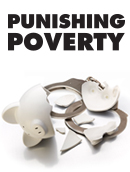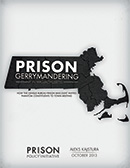Search Results
Your search returned 0 categories and 78 Links.
Pages: [<<] 1 2 3 4 [>>]
-
Getting Tough on Spending: An Examination of Correctional Expenditure in Massachusetts MassINC and the Massachusetts Criminal Justice Reform Coalition, May, 2017“DOC [Department of Corrections] and county facilities combined, the state budget allocation per inmate rose 34 percent between FY 2011 and FY 2016. Over this period, education aid per student increased by only 11 percent.”
-
 Punishing Poverty: The high cost of probation fees in Massachusetts Prison Policy Initiative, December, 2016“Despite evidence that many probationers come from the poorest areas of the state, and the court's ability to waive probation fees, the state manages to collect $20 million per year in fees.”
Punishing Poverty: The high cost of probation fees in Massachusetts Prison Policy Initiative, December, 2016“Despite evidence that many probationers come from the poorest areas of the state, and the court's ability to waive probation fees, the state manages to collect $20 million per year in fees.”
-
The Geography of Incarceration: Boston Indicators Project, MassINC, and the Massachusetts Criminal Justice Reform Coalition, November, 2016“Many people of color live in Boston neighborhoods with such highly concentrated rates of incarceration that nearly every street—in some cases every other building— contains a resident who has been incarcerated.”
-
Breaking Promises: Violations of the Massachusetts Pregnancy Standards & Anti-Shackling Law The Prison Birth Project and Prisoners' Legal Services of Massachusetts, May, 2016“Far too often Massachusetts prisons and jails violate the law in both policy and practice, undermining the public will and subjecting pregnant women to illegal, unsafe, and degrading treatment.”
-
Pretrial Incarcerated Women: An Analysis of Women in Bristol County Jail, Massachusetts Wellesley Centers for Women, March, 2016“This brief policy report examines these women’s demographic and criminal justice characteristics and, focusing particularly on their race and ethnicity, examines the relationships between them.”
-
Exploring the Potential for Pretrial Innovation in Massachusetts MassINC, September, 2015“Since 2008, the state’s pretrial population has grown by nearly 13 percent, while arrests have declined by 10 percent and the number of commitments annually to state prisons and county houses of correction has fallen by 22 percent.”
-
Moving Beyond Incarceration for Women in Massachusetts: The Necessity of Bail/Pretrial Reform Wellesley Centers for Women, March, 2015“Between 2012 and 2014, the number of pretrial women held in the Awaiting Trial Unit (ATU) at MCI-F increased, and overcrowding worsened.”
-
Black, Brown and Targeted: A report on Boston Police Department Street Encounters from 2007-2010 ACLU of Massachusetts, October, 2014(Most alarmingly, the analysis found that Blacks were subjected to 63% of these encounters, even though they made up just 24% of Boston's population. The analysis also showed that crime does not explain this racial disparity.)
-
Closing Massachusetts' Training Schools Reflections Forty Years Later The Annie E. Casey Foundation, June, 2014“...a quiet revolution has begun sweeping through our nation's juvenile justice systems... states across the country have begun shuttering juvenile corrections facilities and dramatically reducing the population of young people incarcerated.”
-
Prison Population Trends 2013 Massachusetts Department of Correction, May, 2014“A steady decline from January 2012 to January 2014 reflects a seven percent decrease in the custody population.”
-
Investigation of the Drug Laboratory at the William A. Hinton State Laboratory Institute 2002-2012 Office of the Inspector General Commonwealth of Massachusetts, March, 2014“Dookhan admitted to”
-
Strategies for Reducing Gun Violence in the Commonwealth of Massachusetts A Report to Speaker of the House of Representatives Robert DeLeo Committee to Reduce Firearm Violence, February, 2014“Massachusetts already has some of the strongest gun laws in the nation. For example, over the last few years the Brady Center ranked Massachusetts 3rd among US states in terms of strength of our gun laws.”
-
 Prison Gerrymandering in Massachusetts: How the Census Bureau prison miscount invites phantom constituents to town meeting Prison Policy Initiative, October, 2013
Prison Gerrymandering in Massachusetts: How the Census Bureau prison miscount invites phantom constituents to town meeting Prison Policy Initiative, October, 2013
-
Prison Population Trends 2012 Massachusetts Department of Correction, May, 2013“The intent of this report is to provide a comprehensive overview of inmate statistics specific to CY2012 as well as trends over the last five to ten years.”
-
Crime, Cost, and Consequences: Is it Time to Get Smart on Crime? MassInc, Community Resources for Justice, March, 2013“If Massachusetts continues on the current course, the analysis contained in this report suggests the state will spend more than $2 billion over the next decade on corrections policies that produce limited public safety benefit.”
-
Massachusetts Department of Correction - 2012 Gordon Haas, Norfolk Lifers Group, March, 2013“Report compares the MA Department of Corrections's stated goals with current practices and outcomes, making suggestions for improvements to promote rehabilitation and reduce recidivism.”
-
Who does the Massachusetts juvenile justice system serve? Citizens for Juvenile Justice, December, 2012“The delinquency charging rates in Barnstable and Hampden counties are 2-3 times higher than some other counties, and roughly twice the statewide average. The charging rates in Bristol and Suffolk Counties are 8 and 6 times the state average.”
-
Three Strikes: The Wrong Way to Justice Charles Hamilton Houston Institute for Race and Justice, Harvard Law School, June, 2012“By properly limiting the applicability of the habitual offender provisions, Massachusetts will be able to reinvest in its people through education, treatment, training, and community development programs.”
-
The Continuing Challenge of CORI Reform Implementing the Groundbreaking 2010 Massachusetts Law The Boston Foundation and The Crime and Justice Institute at CRJ, May, 2012“This report provides information about reactions to whether the implemented elements of the CORI reform law have had the intended impact, and what the public should expect going forward.”
-
Arrested Future The Criminalization of School Discipline in Massachusetts' Three Largest School Districts ACLU of Massachusetts, May, 2012“While there are undoubtedly many reasons why there are more public order arrests in Springfield than in Boston or Worcester, it appears that the manner in which Springfield deploys police officers in its public schools is a contributing factor.”
-
Survey of Sentencing Practices FY 2011 Massachusetts Sentencing Commission, May, 2012“For state prison sentences, the median minimum state prison sentence was 36.0 months and the median maximum state prison sentence was 48.0 months.”
-
A Report on the Massachusetts Department of Corrections - 2011 Gordon Haas, Chairman, Norfolk Lifers Group, January, 2012“The DOC's organizational culture [...] continues to be driven by a penchant for retribution. As a result, what the DOC accomplishes is merely to warehouse prisoners until they are released to become someone else's concern.”
-
Inmate Fees as a Source of Revenue Source of Challenges Massachusetts Executive Office of Public Safety and Security, July, 2011“[A]dditional fees would increase the number of inmates qualifying as indigent, increase the financial burdens on the inmate and their family, and jeopardize inmates' opportunities for successful reentry.”
-
Exploring Alternatives to Incarceration (ATI) for Women in Massachusetts Wellesley Centers for Women, July, 2011“As stated previously, the reason that many women are held in the ATU at MCI-F is because they lacked the financial resources to secure bail set as low as $50.00.”
-
Survey of Sentencing Practices FY 2010 Massachusetts Sentencing Commission, April, 2011“Includes a statistical summary of the last known address of defendants for cities and towns in Massachusetts.”
Pages: [<<] 1 2 3 4 [>>]
Pages Updated On: 4-Apr-2025 - 08:46:50
Links Engine Powered By: Gossamer Threads Inc.
 Punishing Poverty: The high cost of probation fees in Massachusetts Prison Policy Initiative, December, 2016
Punishing Poverty: The high cost of probation fees in Massachusetts Prison Policy Initiative, December, 2016 Prison Gerrymandering in Massachusetts: How the Census Bureau prison miscount invites phantom constituents to town meeting Prison Policy Initiative, October, 2013
Prison Gerrymandering in Massachusetts: How the Census Bureau prison miscount invites phantom constituents to town meeting Prison Policy Initiative, October, 2013